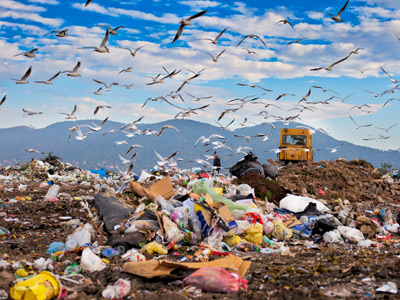Landfill is a sub topic of your geography studies and it is important that you show an understanding of similarities and differences between the production and handling of a variety of waste products and pollution. You also need, as usual, to be aware of the differences between the richer and poorer countries.
The quantity of waste and pollution varies between countries. In the richer countries, consumerism is much greater as the population has a higher disposable income. As a result, they produce a lot of waste that goes into landfill sites. The UK alone produces over 500 kg of waste per person per year where poorer countries like Estonia and Poland produce only half of that. The world's poorest countries produce only about 100 kg of waste per person per year.
There are several reasons for this difference in waste production that you need to know about. One of the things that end up in landfill sites in MEDCs is packaging. It is rare in the West to buy something without packaging, however, in poorer countries, packaging is less frequently used. Literacy levels are lower so people can't read what is on the packaging and in an LEDC, the population is quite likely to buy food from a street trader rather than at a supermarket and take home the produce in a shopping basket that is reused for years.
LEDCs have lower levels of consumerism since incomes tend to be much lower for the average person. This also means that they will reuse and repair items as they cannot afford to buy replacements. Also, they will tend to use fewer disposable items since they are more expensive in the long term and much more difficult to find. In the wealthier countries, disposable items are easy to find in shops and supermarkets and many items like smartphones, tablets and even cars are thrown away in order to buy the newest version. As poorer countries start to develop economically, the quantity of waste they produce also increases.
Solid wastes are dumped into landfill sites. The main problems with landfill are pollution and finding new landfill sites as the existing ones fill up. Some of the materials that end up in landfill sites contain toxic chemicals which can leach into the ground when it rains, polluting water supplies. A new landfill site must therefore not connect with local groundwater that is used to supply drinking water. As the materials rot, they release greenhouse gasses, including methane, which is also highly flammable (and is the main component of natural gas). If the methane gets into homes near to a landfill site it can cause an explosion. Landfill sites often have buried pipes to vent the gasses from rotting materials safely into the air. In larger landfills, sufficient methane is produced to collect and used to power generators to produce small amounts of electricity.
You need to be aware of the various waste management strategies put in place by governments, local authorities and how individuals can make their own small contribution to this growing problem.








